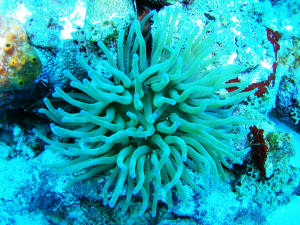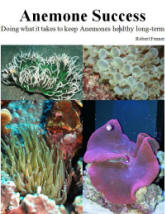|
FAQs on Anemones of the
Caribbean/West Atlantic Disease/Health 1
Related Articles: Anemones,
Anemones of
the Tropical West Atlantic, Colored/Dyed Anemones,
Related FAQs: Atlantic
Anemones 1, Atlantic Anemones 2, Condylactis,
Tropical
West Atlantic (TWA) Anemone Identification, TWA Anemone
Behavior, TWA Anemone
Compatibility, TWA Anemone
Selection, TWA Anemone
Systems, TWA Anemone
Feeding, TWA Anemone
Reproduction,
FAQs by Genus: Actinoporus, Arachnanthus, Bartholomea, Condylactis
(see below), Epicystis, Lebrunia, Sticholdactyla helianthus, Viatrix, Others/Unknowns,
Anemones, Anemones 2,
Clownfishes & Anemones,
Anemone
Lighting, Anemone
Reproduction, Anemone
Identification, Anemone
Selection, Anemone Behavior,
Anemone
Health, Anemone
Placement, Anemone
Feeding,
|

|
 |
New Print and
eBook on Amazon:
Anemone Success
Doing what it takes to keep Anemones healthy long-term
by Robert (Bob) Fenner
|
|
Rock Flower Anemone, Phymanthus/Epicystis crucifer hlth.
8/24/18
Hi Crew!
<Hey Danilo>
I purchased a RFA (the orange one in pics) about 10 days ago, and I noticed it
wasn’t sticky or eating like my established one. Upon further inspection I saw
it’s foot was pinkish with blotchy red, covered with lots of mucous, and
appeared to have a small tear. Even worse, some of his mesenterial filaments
seem to be protruding from the bottom. ��
<Ah yes; a torn pedal disc; tearing at the base; a common issue w/ especially
wild-collected, but includes carelessly extracted captive specimens.>
I was surprised he look so well on his top part especially since I already had
him for 9 days at that point! I know that RFAs notoriously die with any foot
complications, despite iodine dips, revive baths, etc... Again that’s why I was
surprised he even lasted this long.
<Mmm; well... the tearing likely occurred ahead of your acquisition. A note re
"cold" vs. "warm" blooded animals; often such damage, loss of health is a
while... days, weeks in showing up, compared with mammals, birds....>
Anyway, I didn’t want to just give up, and I also did not want to risk trying
methods that have not yielded any solid results, so I am experimenting with
Methylene blue. It has been highly effective as a prophylactic bath for my fish
and acclaimed as being so safe it could be used even for inverts, so I figured
I’d try to give my RFA daily baths.
<Sounds good. As you state, well-worth a try, trialing>
He certainly doesn’t seem to react very negatively to the baths, besides his
mouth opening a little upon reentry into the display. I know he must absorb some
Methylene blue so I only dip him in a cup of display water with only 2 drops, so
hopefully anything expelled into tank isn’t very significant—should I run a
Polyfilter while this is going on?
<I'd run the PolyFilter after administering, every few days... for several
hours, then remove it and replenish the Methylene Blue; as the resins in this
fine product will remove the Methylene Blue>
He’s usually in the bath 5 minutes. I’m on my third day of treatment.
Today his foot was significantly less mucous covered and the degeneration of the
foot seems to have at least halted, but it is still pink and I can still see
maybe a pencil eraser sized bit of mesenterial filaments—an improvement although
still not in the clear. I do the “highly scientific” sniff test to help make
sure he’s hanging in there too, as I know it’s a bit early to even make a
prognosis.
<Okay; appears alive to me>
Well, I wanted to share in case this proves to be successful. I wasn’t sure if
you had any insight in using Methylene blue for RFAs, if I should treat more, or
if my efforts may be futile...?
<I do not know; but have read about, used literally gallons of Methylene Blue
over decades of time in the trade. Is a very safe, and quite effective general
anti- and fungi-cide, bacterio-cide, -static... Is a useful "converter of
hemoglobin", even injected into humans at times/places. Look it up.>
It’s a 28g nano, nitrates and phos undetectable (working on raising that), dkh
9.3, cal 415, Mag 1350, temp avg 82, random turbulent flow from my gyre, and spg
1.025. Tank has no chem filtrants but does have a Aquamaxx hob 1.5.
Dani
<Thank you for sharing. Please do keep us informed of your further work,
observations.
Bob Fenner>
|
.jpeg)
.jpeg) .jpeg) I'd keep separated
I'd keep separated |
|
Rock Flower Anemone, Phymanthus/Epicystis crucifer hlth.
8/24/18
Hi Crew!
<Hey Danilo>
I purchased a RFA (the orange one in pics) about 10 days ago, and I noticed it
wasn’t sticky or eating like my established one. Upon further inspection I saw
it’s foot was pinkish with blotchy red, covered with lots of mucous, and
appeared to have a small tear. Even worse, some of his mesenterial filaments
seem to be protruding from the bottom. ��
<Ah yes; a torn pedal disc; tearing at the base; a common issue w/ especially
wild-collected, but includes carelessly extracted captive specimens.>
I was surprised he look so well on his top part especially since I already had
him for 9 days at that point! I know that RFAs notoriously die with any foot
complications, despite iodine dips, revive baths, etc... Again that’s why I was
surprised he even lasted this long.
<Mmm; well... the tearing likely occurred ahead of your acquisition. A note re
"cold" vs. "warm" blooded animals; often such damage, loss of health is a
while... days, weeks in showing up, compared with mammals, birds....>
Anyway, I didn’t want to just give up, and I also did not want to risk trying
methods that have not yielded any solid results, so I am experimenting with
Methylene blue. It has been highly effective as a prophylactic bath for my fish
and acclaimed as being so safe it could be used even for inverts, so I figured
I’d try to give my RFA daily baths.
<Sounds good. As you state, well-worth a try, trialing>
He certainly doesn’t seem to react very negatively to the baths, besides his
mouth opening a little upon reentry into the display. I know he must absorb some
Methylene blue so I only dip him in a cup of display water with only 2 drops, so
hopefully anything expelled into tank isn’t very significant—should I run a
Polyfilter while this is going on?
<I'd run the PolyFilter after administering, every few days... for several
hours, then remove it and replenish the Methylene Blue; as the resins in this
fine product will remove the Methylene Blue>
He’s usually in the bath 5 minutes. I’m on my third day of treatment.
Today his foot was significantly less mucous covered and the degeneration of the
foot seems to have at least halted, but it is still pink and I can still see
maybe a pencil eraser sized bit of mesenterial filaments—an improvement although
still not in the clear. I do the “highly scientific” sniff test to help make
sure he’s hanging in there too, as I know it’s a bit early to even make a
prognosis.
<Okay; appears alive to me>
Well, I wanted to share in case this proves to be successful. I wasn’t sure if
you had any insight in using Methylene blue for RFAs, if I should treat more, or
if my efforts may be futile...?
<I do not know; but have read about, used literally gallons of Methylene Blue
over decades of time in the trade. Is a very safe, and quite effective general
anti- and fungi-cide, bacterio-cide, -static... Is a useful "converter of
hemoglobin", even injected into humans at times/places. Look it up.>
It’s a 28g nano, nitrates and phos undetectable (working on raising that), dkh
9.3, cal 415, Mag 1350, temp avg 82, random turbulent flow from my gyre, and spg
1.025. Tank has no chem filtrants but does have a Aquamaxx hob 1.5.
Dani
<Thank you for sharing. Please do keep us informed of your further work,
observations.
Bob Fenner>
|
.jpeg)
.jpeg) .jpeg) I'd keep separated
I'd keep separated |
Rock flower nems
3/18/17
Hey guys how has it been.
<Fine Tom; thanks>
Have a quick one about some rock flower nems that we have been getting and
shipping in. We are having a large number melting the second or third day in.
Cal 440, Mag 1350, alk 8 no3 5. They seem to be expelling a large
amount of why looks like green brown stringy material almost like a small hay.
<Mmm; trouble>
They are still solid feeling when introduced to the system.
<Alive up till then likely>
Could they have an issue with the substrate ?
<Doubtful... something/s else. Are they shipped one to the bag? Are their
pedicles intact; i.e., not torn?>
We acclimate them with :30 float and :30 drip.
<I'd be dosing (over; like three plus times) with iodide-ate and lowering the
spg of the acclim. water a thousandth or two>
Have kicked around putting them in a bare bottom and doing water changes ever
hour till they quit expelling that material.
What chemicals can be used to help with these issues
<As above... plus poss. a simple/hexose sugar... as detailed by Hans Hass
decades back and myself in recent ones>
Thanks again
Tom smith
Aquascape Chicago
<Welcome. Bob Fenner>
Re: Rock flower nems
3/18/17
<Can't read this>
Re: Rock flower nems
3/18/17
Sorry about that
The nems all looked in tack in the bags and were shipped 5 per med sized bag.
<Mmm; I'd only ship one per... ALWAYS>
Just found the writing on the simple sugar treatment
What type is sugar works
Cane
Corn syrup
Simple cheap white ?
<Glucose is best... look for this at the supermarket for folks that do canning.
Bob Fenner>
|
|

